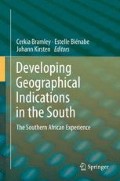Abstract
This chapter seeks to provide criteria for selecting successful GI products. The discussion makes the point that not all origin based products have the potential to benefit equally from GI development and protection. The authors’ experience in selecting products for inclusion in the research project on which this book is based, but also in the subsequent process of designing industry specific GI strategies for two South African GIs (Rooibos and Karoo lamb), has shown that it is possible to identify certain factors which are predictive of an origin product and/or industry’s ability to benefit from GI protection. Drawing on this experience as well as the international literature this chapter seeks to develop guidelines which can be used in Southern countries for evaluating whether a product has the potential to develop into a successful GI and to harness the potential associated with GI protection.
Access this chapter
Tax calculation will be finalised at checkout
Purchases are for personal use only
Notes
- 1.
See Chap. 2 for an explanation of the terms PDO and PGI under EU Regulation 510/2006.
- 2.
This is a departure from previous international agreements such as the Lisbon Agreement which made no reference to reputation.
- 3.
Art. 2.1.b.
References
Barjolle D, Chappuis JM (2000) Transaction costs and artisinal food products. In: Proceedings of the annual conference of ISNIE (International Society for New Institutional Economics), Tuebingen (D), 22–24 Sept 2000
Barjolle D, Sylvander B (2002) Some factors of success for “origin labelled products” in agro-food supply chains in Europe: market, internal resources and institutions. Économies et Sociétés 25(9–10):1441
Barjolle D, Boisseaux S, Dufour M (1998) Le lien au terroir. Bilan des travaux de recherche. Institute of Agricultural Economics, Lausanne
Berard L, Marchenay P (1998) Les produits de terroir en Europe du Sud: caractérisation ethnologique, sensorielle et socio-économique de leur typicité; stratégies de valorisation. Final report. European Commission, Brussels, 372
Boccaletti S (1992) Signaling quality of food products with designations of origin: advantages and limitations. Mimeo, Istitutodi Economia Agro-alimentare, Universita Cattolica del S. Couroe, Piacenza, Italy
Bramley C, Biénabe E (2012) Developments and considerations around geographical indications in the developing world. Queen Mary J Intellect Prop 2(1):14–37
Canali G (1997) The evolution of food distribution systems and its implications on the marketing of typical products. Typical and traditional productions: rural effects and agroindustrial problems. 52nd EAAE seminar, Parma, Italy, 19–21 June
Chappuis JM, Sans P (2000) Actors coordination: governance structures and institutions in supply chains of protected designation of origin. In: Sylvander B, Barjolle D, Arfini F (eds) The socio-economics of origin labelled products in agro-food supply chains: spatial, institutional and co-ordination aspects. Series Actes et Communications, 17(1). INRA, Paris
Das K (2009) Socio-economic implications of protecting geographical indications in India. Centre for WTO studies, August 2009
Gereffi G (1994) The organization of buyer-driven global commodity chains: how United States retailers shape overseas production networks. In: Commodity chains and global capitalism G. Eds.: Gereffi G and Korzeniewicz M (1994). Westport, Praeger, pp 95–122
Hughes J (2009) Coffee and chocolate: can we help developing country farmers trough geographical indications? A report for the International Intellectual Property Institute, Washington, DC, p 152
Jain S (2009) Effects of the extension of geographical indications: a South Asian perspective. Asia-Pac Dev J 16(2):65–86
Jena PR, Grote U (2010) Changing institutions to protect regional heritage: a case for geographical indications in the Indian Agrifood sector. Dev Policy Rev 28(2):217–236
Jenkins T, Parrott N (2000) The socio-economic potential for peripheral rural regions of regional imagery and quality products. In: Sylvander B, Barjolle D, Arfini F (eds) (2000) The socio-economics of origin labelled products in agro-food supply chains: spatial, institutional and co-ordination aspects. Eds: Series Actes et Communications, 17(1). INRA, Paris
Marie-Vivien D (2010) The role of the state in the protection of geographical indications: from disengagement in France/Europe to significant involvement in India. J World Intellect Prop 13(2):121–147
Musungu SF (2008) The protection of geographical indications and the Doha round: strategic and policy considerations for Africa. QUNO IP issue paper 8
Ponte S, Gibbon P (2005) Quality standards, coventions and the governance of global value chains. Econ Soc 34(1):1–31
Prost JA, Casabianca F, De Sainte Marie C (1994) La certification des produits agricoles de Corse. Eléments d’analyse d’une situation paradoxale. In: La Corsica, isola problema tra Europa e Mediterraneo. Atti del Convegno internazionale, Salerno, Università di Salerno
Raynaud E, Valceschini E (1998) Competition regulation against quality policy: the label rouge in the French poultry industry. In: Arfini F, Mora C (eds) Typical and traditional products: rural effect and agro-industrial problems. 52nd EAAE seminar proceedings, Parma, 19–21 June
Sylvander B, Lassaut B (1994) L’enjeu de la qualite sur les marches des produits agro-alimentaires. In: Multon JL (ed) La qualité des produits agroalimentaires: politique, incitations, gestion et contrôle. Lavoisier, Paris
Tregear A, Kuznesof S, Moxey A (1998) Policy initiatives for regional foods: some insights from consumer research. Food Policy 23(5):383–394
Vandecandelaere E, Arfini F, Belletti G, Marescotti A (2009) Linking people, places and products. A guide for promoting quality linked to geographical origin and sustainable geographical indications. Rome, Viale Terme di Caracalla, 00153, Italy: FAO/SINER-GI
Yeung MT, Kerr WA (2011) Are geographical indications a wise strategy for developing country farmers? Greenfields, clawbacks and monopoly rents. J World Intellect Prop 14:353–367
Zografos D (2008) Geographical indications and socio-economic development IQSensato working paper no 3
Author information
Authors and Affiliations
Corresponding author
Editor information
Editors and Affiliations
Rights and permissions
Copyright information
© 2013 Springer Science+Business Media Dordrecht
About this chapter
Cite this chapter
Bramley, C., Biénabe, E. (2013). Guidelines for Selecting Successful GI Products. In: Bramley, C., Bienabe, E., Kirsten, J. (eds) Developing Geographical Indications in the South. Springer, Dordrecht. https://doi.org/10.1007/978-94-007-6748-5_6
Download citation
DOI: https://doi.org/10.1007/978-94-007-6748-5_6
Published:
Publisher Name: Springer, Dordrecht
Print ISBN: 978-94-007-6747-8
Online ISBN: 978-94-007-6748-5
eBook Packages: Earth and Environmental ScienceEarth and Environmental Science (R0)

